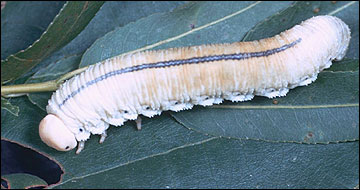Elm sawfly
Sawflies
 Elm sawfly caterpillars (Cimbex americana) are present from summer to fall. They produce one generation per year.
Elm sawfly caterpillars (Cimbex americana) are present from summer to fall. They produce one generation per year.
This is the largest species of sawfly found in North America, with full-grown larvae 1.5 to two inches long. The entire body is light yellow to light green in color, except for a middorsal black stripe. The spiracles are black. When not feeding, the caterpillar will often lie coiled. Preferred host plants are elm and willow, although birch, maple and poplar are occasionally attacked.
About the order
Most species in the order Hymenoptera are beneficial to agriculture as either important pollinators or as biological control agents that prey upon pestiferous insects. However, the hymenopteran group known as "sawflies" feed upon plant tissue and at times can cause serious defoliation. While adult sawflies resemble a wasp or a bee, immature sawflies are caterpillar-like, resembling the immature stage of moths or butterflies. A good diagnostic characteristic that can be used to distinguish between lepidopteran and hymenopteran "caterpillars" is the number of prolegs on the abdomen. Moth and butterfly caterpillars usually have five pairs of prolegs, four pairs on the mid-abdomen and one pair at the end of the abdomen (referred to as anal prolegs). In contrast, sawfly caterpillars typically have six or more pairs of prolegs on the abdomen. Sawfly larvae can cause significant damage to many forest trees (conifer and broadleaf) and landscape trees and shrubs.